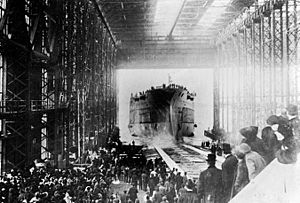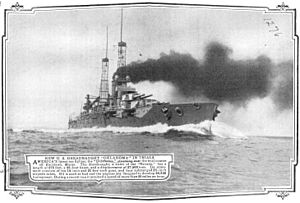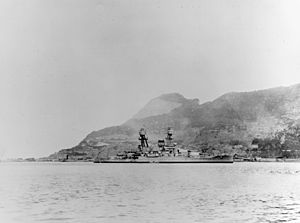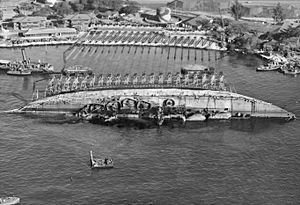USS Oklahoma (BB-37) facts for kids
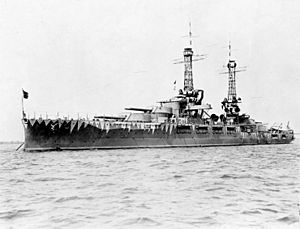
USS Oklahoma (BB-37) at anchor
|
|
Quick facts for kids History |
|
|---|---|
| Name | Oklahoma |
| Namesake | State of Oklahoma |
| Ordered | 4 March 1911 |
| Builder | New York Shipbuilding Corporation, Camden, New Jersey |
| Laid down | 26 October 1912 |
| Launched | 23 March 1914 |
| Commissioned | 2 May 1916 |
| Decommissioned | 1 September 1944 |
| Fate | Sunk in attack on Pearl Harbor, 7 December 1941; refloated for scrapping; sank under tow 1947 |
| General characteristics | |
| Class and type | Nevada-class battleship |
| Displacement | 27,500 long tons (27,900 t) |
| Length |
|
| Beam | 95 ft 6 in (29.1 m) |
| Draft | 28 ft 6 in (8.7 m) |
| Installed power |
|
| Propulsion |
|
| Speed | 20.5 knots (38.0 km/h; 23.6 mph) |
| Range | 8,000 nautical miles (15,000 km; 9,200 mi) at 10 knots (19 km/h; 12 mph). |
| Complement |
|
| Armament |
|
| Armor |
|
| Aircraft carried |
|
The USS Oklahoma (BB-37) was a powerful battleship built for the United States Navy. It was special because it was one of the first American battleships to use oil for fuel instead of coal. This made it faster and able to travel further.
The Oklahoma started its service in 1916. It helped protect ships during World War I. After the war, it sailed in different fleets. The ship was updated between 1927 and 1929. In 1936, it even helped rescue American citizens during the Spanish Civil War. The Oklahoma spent its later years in the Pacific Ocean.
On December 7, 1941, during the attack on Pearl Harbor, Japanese planes attacked the Oklahoma. The ship was hit by several torpedoes and quickly sank. Sadly, 429 crew members died. Many survivors bravely jumped into the water or climbed to safety. In 1943, the Oklahoma was pulled upright and saved from the harbor bottom. However, it was too damaged to fight again. Its parts were removed, and it was sold for scrap in 1946. While being towed for scrapping in 1947, the ship sank in a storm.
Contents
About the USS Oklahoma's Design
The Oklahoma was the second ship in the Nevada-class battleship class. These ships were ordered in 1911. They were the first of the US Navy's "Standard-type" battleships. These ships were designed to be similar in speed, turning, and protection.
A big change was the use of "all-or-nothing" armor. This meant important areas had very thick armor, while less important areas had none. This made the ship stronger where it mattered most. The Nevada class also had triple gun turrets. This allowed them to carry 10 guns in fewer turrets.
Another important change was using oil-fired boilers instead of coal. Oil gave more energy, so the ships could travel longer distances. The Oklahoma used older triple-expansion steam engines. Its sister ship, the Nevada, had newer steam turbines.
The Oklahoma was about 583 feet (178 m) long. It was 95 feet 6 inches (29.11 m) wide. It could travel at a top speed of 20.5 knots (38.0 km/h; 23.6 mph). It was designed to travel 8,000 nautical miles (15,000 km; 9,200 mi) at a slower speed.
The ship's main weapons were ten 14-inch (356 mm)/45 caliber guns. These were in two triple and two twin mounts. It also had many smaller guns for defense. These included 5-inch (127 mm)/51 caliber guns. The ship also had torpedo tubes.
The Oklahoma's Journey: Service History
Building the Ship
The Oklahoma started being built on October 26, 1912. It was built by the New York Shipbuilding Corporation in Camden, New Jersey. The company won the bid to build the ship for $5,926,000.
The ship was launched on March 23, 1914. Lorena J. Cruce, the daughter of Oklahoma's Governor, was its sponsor. This means she officially named the ship. After launching, the ship was moved for fitting-out. This is when the ship's equipment and interior are completed.
In July 1915, a fire broke out on the ship. This delayed its completion. The Oklahoma was finally commissioned on May 2, 1916. Captain Roger Welles was its first commander.
World War I Service
After it was commissioned, the Oklahoma stayed along the East Coast of the United States. It could not join other battleships in Europe at first. This was because there was no oil fuel available there. In 1917, the ship was updated. It received antiaircraft guns.
Life on board was busy. Sailors had chances for education. They also competed in sports like boxing and rowing. These activities helped build teamwork among the crew.
On August 13, 1918, the Oklahoma sailed to Europe. It joined Battleship Division Six. Their job was to protect American convoys. These convoys were groups of supply ships. The division stayed in Ireland. They were only called out once to escort troop ships.
During this time, six crew members died from the 1918 flu pandemic. The war ended on November 11, 1918. After the war, some Oklahoma sailors had fights with local people. The ship's commander had to apologize.
Between the World Wars
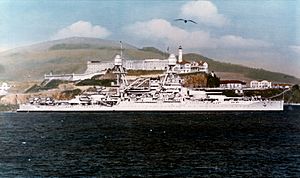
The Oklahoma returned to New York in December 1918. It spent early 1919 doing winter training near Cuba. In June 1919, it escorted President Woodrow Wilson to France. For the next two years, it was part of the Atlantic Fleet. Its crew trained and the ship was repaired.
In 1921, the Oklahoma sailed to South America. It did training exercises with the Pacific Fleet. Later that year, it returned for the Peruvian Centennial celebration. Then, it joined the Pacific Fleet.
In 1925, the Oklahoma went on a long training cruise. It sailed from San Francisco to Hawaii. There, it took part in war games. Then, it visited Samoa, Australia, and New Zealand. It returned to the United States later that year.
In November 1927, the ship went to the Philadelphia Naval Shipyard for a big update. It received new guns. Its main gun turrets could now aim higher. An aircraft catapult was added for planes. The ship also got much more armor. This included anti-torpedo bulges. These bulges made the ship wider. They also made it a bit slower.
After its updates, the Oklahoma joined the Scouting Fleet. It returned to the West Coast in 1930. It stayed there until 1936. That summer, it took naval students on a training trip to Europe. This trip was cut short by the Spanish Civil War. The Oklahoma sailed to Spain to rescue American citizens. It took them to safer ports.
The Oklahoma then returned to the West Coast. For the next four years, it trained with the Army. It also trained naval reservists. From December 1937, the Oklahoma was based at Pearl Harbor. It patrolled and did exercises there.
In early 1941, it went to the Puget Sound Naval Shipyard for more anti-aircraft guns and armor. In August 1941, it went to San Pedro for more repairs. On the way, a big storm hit the ship. One sailor was swept overboard. The ship's propeller shaft broke. This forced it to go to San Francisco for repairs. It stayed there until mid-October. Then, it returned to Hawaii. The ship was supposed to be retired in May 1942.
The Attack on Pearl Harbor
On December 7, 1941, the Japanese attacked Pearl Harbor. The Oklahoma was docked next to the battleship Maryland. Japanese planes immediately targeted it. The Oklahoma was hit by three torpedoes. The first two hit around 7:56 AM. They damaged the ship's side. About 80 men tried to get to the anti-aircraft guns. But they couldn't use them because the firing parts were locked away.
The third torpedo hit at 8:00 AM. It broke through the ship's hull. The Oklahoma began to tip over. Two more torpedoes hit as it was sinking. Sailors were shot at as they left the ship. In less than 12 minutes, the ship rolled over. Its masts touched the bottom of the harbor. Its right side was above water. It is thought the ship was hit by eight torpedoes in total.
Many crew members kept fighting. They climbed onto the Maryland to help with its anti-aircraft guns. Sadly, 429 officers and sailors were killed or went missing. One of them was Father Aloysius Schmitt, a chaplain. He was the first American chaplain to die in World War II. Thirty-two others were hurt. Many were trapped inside the overturned ship.
Rescue efforts started quickly. They continued into the night. A civilian worker named Julio DeCastro helped save 32 sailors. Rescuers had to drill holes and open hatches. It was dangerous because cutting the hull could release trapped air. This would raise water levels inside. Some survivors might not have been reached in time.
Some of those who died had ships named after them. These include Ensign John C. England and Chief Carpenter John Arnold Austin. Austin received the Navy Cross for his brave actions. Ensign Francis C. Flaherty and Seaman James R. Ward received the Medal of Honor.
Saving the Ship: Salvage Operations
By early 1942, it was decided that the Oklahoma could be saved. It was also blocking the harbor's shipping lane. So, the job of salvaging the Oklahoma began on July 15, 1942. Captain F. H. Whitaker led the team.
It took almost eight months to prepare the ship. Air was pumped into the ship's rooms. This pushed 20,000 tonnes (19,684 long tons; 22,046 short tons) of water out through the torpedo holes. Special soil was placed in front of the ship to stop it from sliding. Two barges helped control the ship as it rose.
Twenty-one large cranes were attached to the ship. They used strong steel cables connected to machines on shore. The process of pulling the ship upright began on March 8, 1943. It was finished by June 16, 1943. Teams then went inside the ship to remove human remains.
Cofferdams were built around the hull. This allowed basic repairs to be made. The ship could then float again. This work was done by November. On December 28, the Oklahoma was towed into a drydock. There, its guns, engines, and other parts were removed. The worst damage to the hull was also fixed.

The Oklahoma was officially taken out of service on September 1, 1944. All its remaining weapons and parts were removed. It was then put up for sale in November 1946. It was sold for $46,127 to Moore Drydock Co. in California.
The Final Journey
In May 1947, two tugboats began towing the Oklahoma's hull from Pearl Harbor. It was heading to San Francisco Bay. A group of people from Oklahoma planned to visit the ship.
But on May 17, a storm hit the ships. They were over 500 miles (800 km) from Hawaii. The tugboat Hercules saw that the Oklahoma was tipping heavily. Both tugs were told to turn back. Suddenly, the Hercules was pulled backward. The Oklahoma was sinking straight down. Water rushed over the back of both tugboats.
Luckily, both tug captains had loosened their tow lines. As the battleship sank fast, the line from one tug quickly came loose. But the Hercules's cables did not release until the last moment. The Oklahoma sank quickly. Its exact location is not known.
Memorials and Remembering the Crew
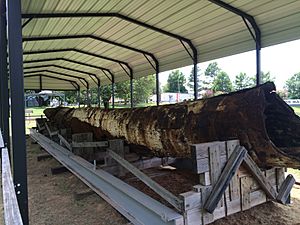
In 2006, the US Navy found a part of the Oklahoma at the bottom of Pearl Harbor. It was a piece of the ship's mast. It was flown to Tinker Air Force Base. Then, it was taken to the Muskogee War Memorial Park in Muskogee. This 40-foot-long (12 m), 25,000-pound (11,340 kg) mast section is now on display. The ship's bell and two of its propellers are at the Kirkpatrick Science Museum in Oklahoma City. The Oklahoma's back steering wheel is at the Oklahoma History Center.
On December 7, 2007, a memorial was dedicated for the 429 crew members who died. It is on Ford Island, near where the battleship Missouri is docked. The USS Oklahoma memorial is part of the Pearl Harbor National Memorial. It has black granite walls and white marble posts.
Only 35 of the 429 sailors and Marines who died were identified right after the attack. The remains of 388 unidentified crew members were buried. In 1947, they were dug up to try and identify more people, but it didn't work. In 1950, all unidentified remains from Oklahoma were buried in a national cemetery.
In 2015, the Department of Defense announced a new plan. They would dig up the unidentified remains of the Oklahoma's crew. They would use DNA testing to identify them. This process began in June 2015. As of December 2017, 100 had been identified. By December 2020, 281 missing crew members had been identified. By February 2021, the total was 301.
Images for kids
-
USS Wisconsin is tied up outboard of the hull of Oklahoma at Pearl Harbor Navy Yard on 11 November 1944. Note the great difference in the length of the two battleships.
-
A mast leg from Oklahoma in War Memorial Park in Muskogee, Oklahoma. The mast section is on permanent loan from the Navy.
See also
 In Spanish: USS Oklahoma (BB-37) para niños
In Spanish: USS Oklahoma (BB-37) para niños


